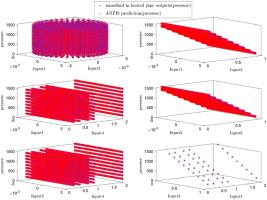Case Studies in Thermal Engineering ( IF 6.4 ) Pub Date : 2020-11-27 , DOI: 10.1016/j.csite.2020.100793 Azam Marjani , Meisam Babanezhad , Saeed Shirazian

|
The computational fluid dynamics (CFD) modeling is an applicable tool for the prediction of fluid flow characteristics (velocity, temperature, pressure, etc.). However, CFD requires a lot of time, computational efforts and as a result, much more expenses for complicated cases (e.g. turbulent flow, 3-dimensional calculations, etc.). The present work tries to conduct an investigation on the potential of the artificial intelligence algorithms in overcoming such barriers of CFD modeling. Turbulent forced convection of Cu/water nanofluid in a tube under constant heat flux is considered as a case study for the model development. The density and viscosity of the based fluid are enhanced by the suspension of the nanoparticles. This makes more pressure drop and as a result, imposes more pumping power. So, this paper is focused on a way to facilitate the prediction of the pressure of the nanofluid convective flow. The results of the CFD modeling are learned by the adaptive network-based fuzzy inference system (ANFIS), as the artificial intelligence method. The CFD modeling is done for several Cu nanoparticle volume fractions (i.e. 0.3, 0.5, 0.8, 1, and 2). Several types of variables as inputs (i.e. x, y, z, and nanoparticle volume fraction) and different kinds of membership functions (i.e. Generalized bell-shaped membership function (gbellmf), Gaussian membership function (gaussmf), Gaussian combination membership function (gauss2mf), Difference between two sigmoidal membership functions (dsigmf), Product of two sigmoidal membership functions (psigmf)) are examined until the intelligence requirements of the ANFIS are satisfied. Once the best intelligence of ANFIS has been achieved, there is no need for complicated CFD modeling. The ANFIS predictions show the highest compatibility with the CFD results. The maximum pressure drop was predicted around 1500 Pa. The results also revealed that for checking the intelligence condition the coefficient of determination (R2) is not solely sufficient and the error values must be considered as well. Considering the gauss2mf as the membership function and the nanoparticle volume fraction as the fourth input, the ANFIS could distinguish intelligently the pattern of data (changing the pressure with coordinates and particle fraction). For the best intelligence, the mean standard error was around zero, while the coefficient of determination was close to one. At this condition, the pressure of the nanofluid could be determined as a function of the nanoparticle volume fraction and anywhere inside the tube without using the CFD modeling.
中文翻译:

基于自适应网络的模糊推理系统(ANFIS)在铜/水纳米流体对流流动数值研究中的应用
计算流体动力学(CFD)建模是用于预测流体流动特性(速度,温度,压力等)的适用工具。但是,CFD需要大量的时间,计算量,结果,在复杂的情况下(例如湍流,3维计算等)会花费更多的费用。本工作试图对人工智能算法克服CFD建模障碍的潜力进行研究。在恒定热通量下,管中的铜/水纳米流体的湍流强迫对流被认为是模型开发的案例研究。通过纳米颗粒的悬浮来提高基础流体的密度和粘度。这会导致更多的压降,从而增加泵送功率。所以,本文着重于一种有助于预测纳米流体对流流动压力的方法。CFD建模的结果是通过基于自适应网络的模糊推理系统(ANFIS)作为人工智能方法来学习的。对几个Cu纳米粒子的体积分数(即0.3、0.5、0.8、1和2)进行了CFD模拟。几种类型的变量作为输入(即x,y,z和纳米粒子体积分数)和不同类型的隶属函数(即广义钟形隶属函数(gbellmf),高斯隶属函数(gaussmf),高斯组合隶属函数(gauss2mf ),检查两个S形隶属度函数(dsigmf)之间的差异,两个S形隶属度函数(psigmf)的乘积),直到满足ANFIS的智能要求为止。一旦获得了ANFIS的最佳智能,就无需进行复杂的CFD建模。ANFIS预测显示与CFD结果的最高兼容性。预计最大压降约为1500 Pa。结果还表明,对于检查智能状况,确定系数为(R2)不仅足够,还必须考虑误差值。将gauss2mf作为隶属函数,将纳米颗粒体积分数作为第四输入,ANFIS可以智能地区分数据模式(用坐标和颗粒分数改变压力)。为了获得最佳情报,平均标准误差约为零,而确定系数接近于一。在这种情况下,无需使用CFD建模,就可以将纳米流体的压力确定为纳米颗粒体积分数和管内任何位置的函数。











































 京公网安备 11010802027423号
京公网安备 11010802027423号